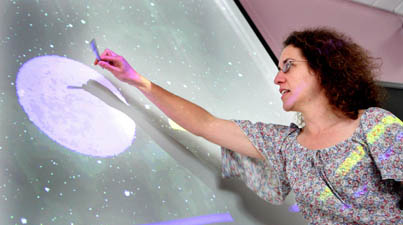Homer's Physics lecture series simplifies science
Homer's Physics lecture series simplifies science McGill University
User Tools (skip):
Homer's Physics lecture series simplifies science

Astrophysicist Vicky Kaspi brings her high-flying research down to earth.
OWEN EGAN
When is a pulsating star like a leotard-clad figure skater or the whistle of a repeatedly passing train? When it's explained to a group of people whose grasp of physics is tenuous enough to make Homer Simpson look like Albert Einstein.
Such analogies, along with the occasional cartoon video clip, help make sense of science in a new 'in-reach' lecture series for non-scientists called Homer's Physics. An initiative of McGill's Department of Physics, the monthly series presents complex research in layman's terms to the department's technical, clerical and managerial staff.
It all started a year ago when administrative coordinator Louise Decelles and administrative officer Diane Koziol ran into Astrophysics Professor Andrew Cumming while chatting in the hallway about celestial matters.
"I told him that I would really love to visit the Hubble telescope," recalled Decelles. "I didn't realize at the time that the telescope is in outer space. He laughed."
Prof. Cumming would later be the first lecturer in what was originally planned as a series of research seminars to help integrate new researchers into the department.
Since then, it has blossomed into a popular, informal team-building exercise that has helped support staff provide better, more informed support while giving researchers a chance to flex their presentation muscles and, perhaps, even come to see their own work in a new light.
"When you're up to your eyeballs in research, you don't realize that sometimes the best questions come from people who don't know anything about your work," said Prof. Vicky Kaspi, a world-renowned expert on neutron stars who holds a Canada Research Chair in Observational Astrophysics and the Lorne Trottier Chair in Astrophysics and Cosmology. "It's also a nice way to remind yourself of how fun and cool your work really is."
Kaspi elicited several questions and more than the occasional 'Ahh!' of epiphany during her recent presentation on neutron stars, the dense, rapidly rotating stars created from the collapse of a larger star: "What makes a pulsar a pulsar?" "Does it always stay bright or does it fade away?"
Over the course of about an hour, Kaspi would answer these questions and more, in the simplest of terms. Of course, the video of the rapidly rotating figure skater helped make the presentation accessible enough for even Homer Simpson to understand—hence, the name of the lecture series.
And if the image of a figure skater doesn't quite light one's personal bulb of recognition, consider this: one of the more rapidly rotating neutron stars is believed to spin roughly at the speed of the Vita-Mix 5000, reputed to be the fastest-spinning blender on the market. As for the passing train whistle, it's akin to the sound emitted—via radio waves—by a more slowly spinning star. 'Ahh!'
Homer's Physics has been so successful that it recently earned a national first prize in the Canadian Association of University Business Officers' annual Quality and Productivity Awards.
As a bonus, the series has made work just a little more fun, according to Diane Koziol.
"I've been here 20 years, and actually knowing what people around you are doing makes things a lot more interesting," she said.

